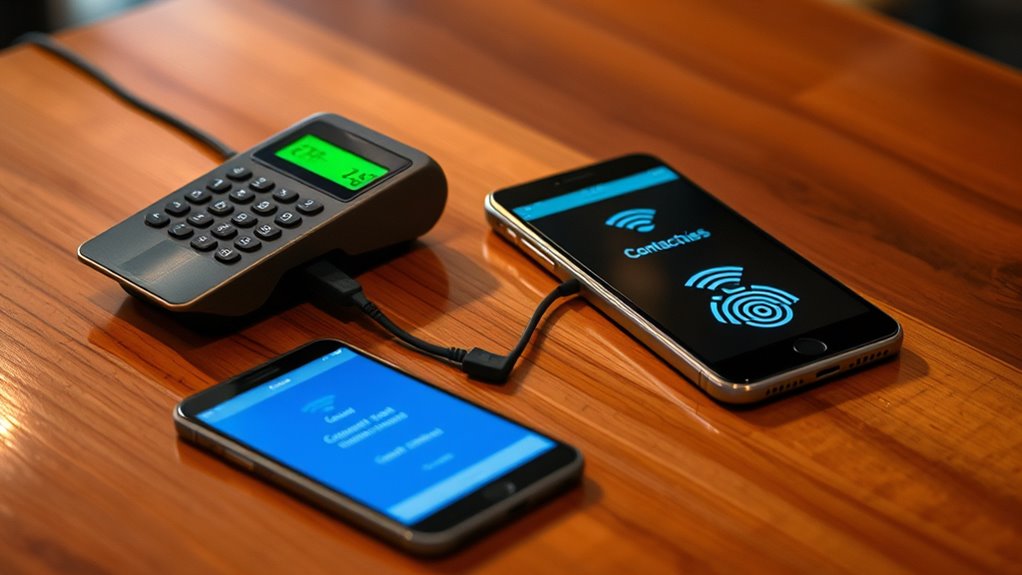Payment processing has evolved from ancient barter and paper currency to today’s instant digital systems. Coins and checks laid the foundation, while electronic transfers via telegraph and early networks made transactions faster. The introduction of credit cards, ATMs, and magnetic stripes transformed convenience and security. With the rise of online shopping and mobile payments, technology continues to advance. If you’re curious how these innovations shaped the way we pay today, there’s more to uncover.
Key Takeaways
- Magnetic stripe cards introduced in the 1960s enabled secure, quick transactions at ATMs and retail stores.
- Electronic fund transfers evolved from telegraph-based methods to automated systems like ACH in the 1970s.
- Digital payment innovations, including online platforms like PayPal, emerged in the 1990s, facilitating e-commerce transactions.
- Mobile payments began with smartphones in 2007, enabling contactless payments and in-store shopping convenience.
- Payment processing technology has advanced from manual swipe cards to seamless, secure digital solutions like Stripe and other online payment gateways.

Have you ever wondered how the way we pay for goods and services has evolved over time? It’s a fascinating journey that reflects human ingenuity and technological advances. You might be surprised to learn that paper currency first appeared in China during the Tang dynasty around the 10th century and eventually made its way to the West by the 17th century. Checks became popular in the 19th and early 20th centuries, offering a more convenient way to transfer money. Then, in 1913, the U.S. created the Federal Reserve to centralize currency and banking regulation, paving the way for a more organized financial system. Early electronic fund transfers started with telegraph technology, like the transatlantic cable in 1866 and Fedwire in 1918, which made quick transfers across distances possible. These innovations laid the groundwork for modern digital finance. In 1972, the Automated Clearinghouse (ACH) was established to handle check processing limits and became a key electronic transfer method still in use today, simplifying how money moves electronically.
From paper currency to digital payments—an incredible journey of innovation in how we manage money.
The birth of payment cards marked a significant turning point. In 1950, Ralph Schneider and Frank McNamara introduced the Diners’ Club charge card, requiring full monthly payments. This innovation led to the first credit card by American Express in 1959, which allowed users to carry a balance from month to month. Mastercard emerged in the late 1960s as a competitor to Visa, created by regional banks uniting to challenge existing giants. Magnetic stripe cards were introduced around this time, enabling secure transactions at ATMs and stores, thanks to PIN encryption. These advances created the foundation for the modern payment card ecosystem that we rely on today. Additionally, the development of high-speed data processing technology improved transaction efficiency and security.
The introduction of ATMs in the late 1960s revolutionized banking. Barclays installed the first ATM in London in 1967, followed by Chemical Bank’s first U.S. ATM in 1969. These machines allowed you to withdraw cash and check account balances anytime, reducing dependence on bank hours. Over time, features like encrypted PINs and computer displays made ATMs more secure and user-friendly. In 2013, Interactive Teller Machines (ITMs) added video links to remote tellers, further enhancing self-service banking. This shift made banking more accessible and convenient.
Digital finance continued to evolve with the creation of online and mobile payment platforms. The first B2B electronic transaction happened in 1981, and by 1994, consumers could make online payments after the internet became widely available. E-commerce giants like Amazon and PayPal expanded online shopping and secure digital payments. The launch of smartphones in 2007 introduced mobile payments, allowing you to shop and pay from your pocket. From swiping cards to tapping smartphones, each step reflects a relentless drive toward faster, safer, and more accessible ways to handle money. The history of payment processing tech is a story of innovation transforming how you buy, sell, and manage your finances every day.
Frequently Asked Questions
How Do Contactless Payments Work Securely?
You might wonder how contactless payments stay secure. They use tokenization, replacing your card details with unique, transaction-specific tokens. Encryption secures data during transmission, and dynamic authentication creates a cryptographic code each time. Proximity limits reading distance, and biometric or two-factor authentication adds extra protection. Real-time fraud monitoring detects suspicious activity, while industry standards like PCI DSS and EMV guarantee your transactions adhere to strict security protocols, keeping your data safe.
What Are the Latest Innovations in Payment Tech?
Imagine you’re in 2023, and the latest payment tech feels like sci-fi. You benefit from real-time payments that process instantly, enabling seamless cross-border transactions. Biometric authentication speeds up your checkout, replacing PINs with fingerprints or facial scans. AI detects fraud proactively, protecting your money. Embedded finance integrates payments into apps you already use, and blockchain boosts security and speed in B2B dealings. These innovations make payments faster, safer, and more convenient than ever before.
How Does Blockchain Impact Payment Processing?
Blockchain transforms payment processing by making transactions more secure and transparent through distributed ledgers and cryptographic security. It speeds up cross-border payments by removing intermediaries, reducing settlement times from days to minutes. You benefit from lower fees, real-time settlement, and enhanced privacy with control over your digital identity. While scalability and regulation pose challenges, emerging solutions aim to make blockchain a more efficient, reliable backbone for global payments.
What Are Common Challenges in Digital Payments?
Imagine you’re expanding your online store globally, but face rising cyber fraud and complex regulations. Common challenges in digital payments include security risks like data breaches, high processing fees, and compliance issues across borders. Outdated systems can slow transactions, while fragmented regulations make global operations tough. To succeed, you need real-time fraud detection, streamlined processes, and adaptable tech that meets evolving security and legal standards.
How Is AI Used in Payment Fraud Detection?
You’re wondering how AI helps detect payment fraud. AI uses supervised, unsupervised, and semi-supervised models to spot suspicious transactions by analyzing patterns, anomalies, and relationships across data. It works in real-time to flag unusual activity, like device fingerprinting, behavioral biometrics, or transaction metadata. AI continuously learns from new data, improving accuracy and adaptability, making fraud detection faster, more precise, and scalable, ultimately protecting your payments more effectively.
Conclusion
Just like a well-choreographed dance, payment processing tech has evolved seamlessly over time, turning complicated steps into smooth moves. Remember when swiping a card felt like a clumsy shuffle? Now, with Stripe and other tech, transactions flow effortlessly—almost invisible. It’s like watching a caterpillar become a butterfly, transforming complexity into elegance. As technology advances, you can expect payments to keep getting simpler, faster, and more secure, making your financial dance even more effortless.









